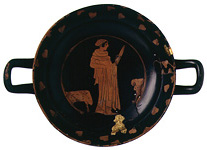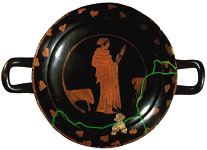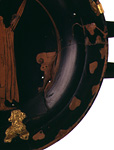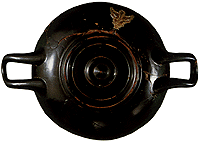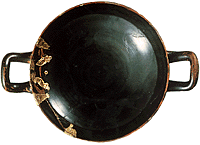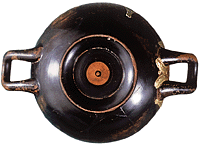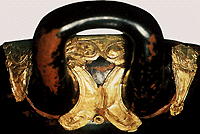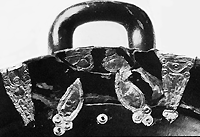Kleinaspergle: Attic kylikes
Both cups are of a type made in Athens around 450 BCE and widely exported. They are shallow drinking cups with low, ring-shaped feet and an offset inner rim painted with a floral design.
The views here are after a recent de-restoration, in the course of which all gold foil pieces were removed whose exact original location had not been recorded. There are numerous (at least 16) additional gold pieces which unquestionably belong to these cups. The gold foil additions were made at Kleinaspergle or in the vicinity of the Hohenasperg. (Böhr 1988, 176 ff.; Schaaf 1988, 191-195).
The cups were both broken and mended in antiquity. The repairs are also thought to have been made by the Asperg Celts. Schaaf suggests that the handles were broken off during an inept game of kottabos, a common motif in Greek and South Italian red-figure vase painting (1988, 191) . The symposiast, still reclining, swings his kylix about by one handle in order to fling the dregs of his wine at a target. We have no way of knowing whether the Celts knew about this custom, nor whether they would have correctly interpreted vase paintings with such depictions. Schaaf's scenario of clumsy barbarians trying to imitate sophisticated Mediterranean drinking habits is predicated on the assumption that the Celts imported Greek ideas and customs along with the objects, out of a desire to emulate the Greeks. The otherwise very Celtic funerary context in which these cups were found suggests that, on the contrary, the cups were integrated into local usages and customs.
The remarkable gold foil pieces were applied without regard for the Greek ornament. On both cups, they overlap portions of the painted florals on the interior rims; in the case of the Amphitrite painter's kylix, even the tondo painting is not spared. The foils are emphatically Celtic, early La Tène in style. They suggest a Celtization of the cups rather than a Hellenization of the Asperg Celts.
Attic red-figure kylix by the Amphitrite Painter. 5.1 cm H; 15.5 cm Dia (22.2 cm Dia with handles). Interior rim: ivy. Tondo: Woman with torch at altar.
Black glaze Kylix, probably from the same Attic workshop. 5.1 cm H; 15.4 cm Dia (21.9 cm Dia with handles)


